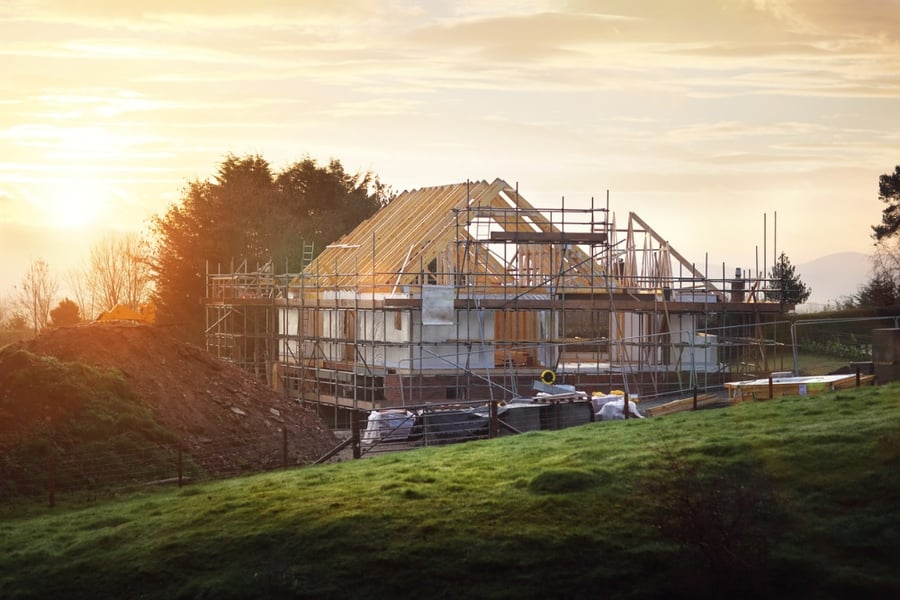The pros and cons of self-build mortgages

What is a self-build mortgage?
Traditional mortgages provide a single lump sum once the project is completed, but a self-build mortgage, on the other hand, releases the money at various stages during the building process. There are a few crucial considerations you should factor in prior to applying for a self-build mortgage, including:
- You have to provide a breakdown and the plans of your costs to build (this breakdown should also include your plot cost);
- For any issues that you may face during the build, you should include what is called a contingency fund;
- You should take into account that interest rates for self-build mortgages are usually more expensive than remortgage rates or standard home mortgages, and, depending on the lender, arrangement fees will likely vary; and
- You should shop around for a lender that will let you switch to a lower interest rate after your self-build is liveable.
How does a self-build mortgage work?
Self-build mortgages act differently than traditional mortgages in that they release funds in stages to create the funds you need to build your home, as well as pay your contactors and whatever materials you need.
If you are unable to finance the entire build out of your own pocket, a self-build mortgage would be the most viable option. With this type of mortgage, however, comes its own set of limitations, like the fact that self-build mortgages are not as readily available, meaning they’ll likely be less competitive. Additionally, it’s likely they will not offer you the most competitive rates, depending of course on the type of self-build mortgage you go with.
Normal mortgage vs self-build mortgage: What’s the difference
The key differences between a normal mortgage and a self-build mortgage include the following:
Normal mortgage. The funds are released in one lump sum; the interest rates for traditional mortgages are usually lower than self-build mortgages; the property has to meet the criteria of the lender for condition and construction; and typically a normal mortgage is purely for those properties that are in habitable condition.
Self-build mortgage. As the build progresses, self-build mortgage funds are released in various stages. Fees and interest rates usually are more expensive than a normal mortgage; the lender’s criteria has to be met at each stage of the build, including non-standard construction methods; and self-build mortgages can be put toward renovating an unhabitable building.
Types of self-build mortgages
Generally, there are two types of self-build mortgages that you can pick, including:
Arrears mortgages. An arrears mortgage will be the best choice for you if you have a lot of cash on hand to finance a portion of your self-build home. The reason is that arrears mortgages will give you payments in stages to align with the different stages of completion, which means you have to provide the cash upfront but will ultimately be compensated.
Advance mortgages. Advance mortgages, on the other hand, release payments at the beginning of each stage of build, meaning these types of mortgages make the most sense for anyone who relies on the mortgage to fund each build stage. It would also mean that, if you were to take out an arrears self-build mortgage, you would not need bridging or short-term loans to cover the build costs up front. For the majority of home builders, advance mortgages make the most sense since they are more helpful with cash flow. Since fewer providers offer advance mortgages, however, the rates are less competitive.
Pros and cons of a self-build mortgage
When you are planning your finances for a self-build, it is critical to weigh the pros and cons of a self-build mortgage.
Advantages: A self-build mortgage is a great way to get the funding necessary to build your home, and you will likely find that the higher interest rate (versus a conventional mortgage) will balance out with the money you save on building yourself.
Disadvantages: You will be required to pay a bigger deposit, something in the ballpark of at least 50%; fees and interest rates are typically more costly than for conventional mortgages; you will have less of a choice of lenders; and until the lender gives the okay on the current completed stage, you will be unable to procure money for the subsequent stage of your build, which could put a kink in your plan to book tradespeople and purchase materials.
Are self-build mortgages hard to get?
There are a number of factors that may affect your ability to borrow the funds to build your home, including where you live and your monthly mortgage or rental payments. Your monthly income vs. expenditure are not impacted if your lender accepts you making rental payments up front, for instance.
Since every lender’s criteria differs, you will need to make sure you know your build type and payment terms and conditions that are stipulated by your supplier. Lenders can request that a qualified quantity surveyor gives the info on build costs; others might need you to complete the project to a fixed build-cost budget.


